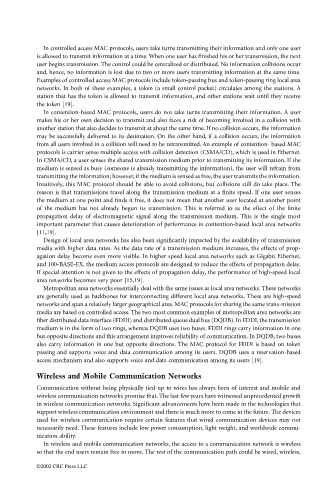Page 1077 - The Mechatronics Handbook
P. 1077
In controlled access MAC protocols, users take turns transmitting their information and only one user
is allowed to transmit information at a time. When one user has finished his or her transmission, the next
user begins transmission. The control could be centralized or distributed. No information collisions occur
and, hence, no information is lost due to two or more users transmitting information at the same time.
Examples of controlled access MAC protocols include token-passing bus and token-passing ring local area
networks. In both of these examples, a token (a small control packet) circulates among the stations. A
station that has the token is allowed to transmit information, and other stations wait until they receive
the token [19].
In contention-based MAC protocols, users do not take turns transmitting their information. A user
makes his or her own decision to transmit and also faces a risk of becoming involved in a collision with
another station that also decides to transmit at about the same time. If no collision occurs, the information
may be successfully delivered to its destination. On the other hand, if a collision occurs, the information
from all users involved in a collision will need to be retransmitted. An example of contention- based MAC
protocols is carrier sense multiple access with collision detection (CSMA/CD), which is used in Ethernet.
In CSMA/CD, a user senses the shared transmission medium prior to transmitting its information. If the
medium is sensed as busy (someone is already transmitting the information), the user will refrain from
transmitting the information; however, if the medium is sensed as free, the user transmits the information.
Intuitively, this MAC protocol should be able to avoid collisions, but collisions still do take place. The
reason is that transmissions travel along the transmission medium at a finite speed. If one user senses
the medium at one point and finds it free, it does not mean that another user located at another point
of the medium has not already begun its transmission. This is referred to as the effect of the finite
propagation delay of electromagnetic signal along the transmission medium. This is the single most
important parameter that causes deterioration of performance in contention-based local area networks
[11,19].
Design of local area networks has also been significantly impacted by the availability of transmission
media with higher data rates. As the data rate of a transmission medium increases, the effects of prop-
agation delay become even more visible. In higher speed local area networks such as Gigabit Ethernet,
and 100-BASE-FX, the medium access protocols are designed to reduce the effects of propagation delay.
If special attention is not given to the effects of propagation delay, the performance of high-speed local
area networks becomes very poor [15,19].
Metropolitan area networks essentially deal with the same issues as local area networks. These networks
are generally used as backbones for interconnecting different local area networks. These are high-speed
networks and span a relatively larger geographical area. MAC protocols for sharing the same trans-mission
media are based on controlled access. The two most common examples of metropolitan area networks are
fiber distributed data interface (FDDI) and distributed queue dual bus (DQDB). In FDDI, the transmission
medium is in the form of two rings, whereas DQDB uses two buses. FDDI rings carry information in one
but opposite directions and this arrangement improves reliability of communication. In DQDB, two buses
also carry information in one but opposite directions. The MAC protocol for FDDI is based on token
passing and supports voice and data communication among its users. DQDB uses a reservation-based
access mechanism and also supports voice and data communication among its users [19].
Wireless and Mobile Communication Networks
Communication without being physically tied-up to wires has always been of interest and mobile and
wireless communication networks promise that. The last few years have witnessed unprecedented growth
in wireless communication networks. Significant advancements have been made in the technologies that
support wireless communication environment and there is much more to come in the future. The devices
used for wireless communication require certain features that wired communication devices may not
necessarily need. These features include low power consumption, light weight, and worldwide commu-
nication ability.
In wireless and mobile communication networks, the access to a communication network is wireless
so that the end users remain free to move. The rest of the communication path could be wired, wireless,
©2002 CRC Press LLC

